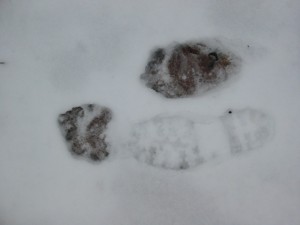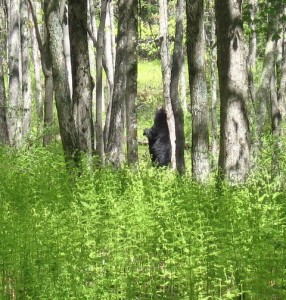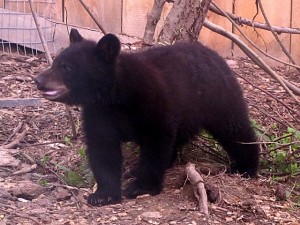Enjoy Winter! Black Bears
by Tim Burris, Preserve Manager
Black Bears (Ursus americanus) have a really interesting strategy for dealing with the winter. Their winter sleep is not considered true hibernation by some scientists, but it is truly remarkable. If you remember from an earlier post, groundhogs are considered true hibernators because they radically lower their metabolism (body temperature, heart rate, and respiration) for extended periods. Bears by contrast, lower these functions but not enough to drastically lower their energy needs. This fact makes their winter sleep even more amazing.
Like Groundhogs and Deer, black bears binge eat in the fall. Bears can increase their weight substantially (40%) before denning. Their winter layer of fat will be several inches thick and provides insulation as well as nourishment. The decision to den is closely related to food availability, or more accurately calories. Bears will generally den when the calories expended to find food exceeds the calories gathered. Females usually den in November. Males can stay active through December if food is abundant and not covered by snow.
Because they aren’t true hibernators, bears burn calories at basically the same rate as we would while asleep. This is where things get pretty amazing. Burning calories produces by-products, in particular toxic urea. We rid our bodies of these toxins when we urinate. Bears, however, don’t urinate or defecate during their winter sleep. (You’ll recall that even groundhogs rise from their hibernation periodically to void waste products.) Bears have the amazing ability to recycle urea back into proteins. This process allows them to maintain muscle mass and avoid urea toxicity.
(Bear cub photo by Carole Mebus)
Bears also have their babies during the winter during pseudo-hibernation. (In Pennsylvania, females generally become sexually mature in their second spring, and can have young every two years.) Bears mate in June and July, but the fertilized embryo survives in a suspended state for several months until the female dens. Then it becomes implanted on the uterus and begins to develop. This delayed implantation is a safety measure in case a female isn’t able to find enough food in fall. Implantation will only occur if the mother has built up enough resources for bearing cub(s). Young are born only 7 weeks later in early January, while the mother is still in the den. So, during her deep sleep a pregnant bear has her babies and begins nursing, all nourished by just her fat reserves. Remember during this time she doesn’t eat or drink, and she doesn’t go to the bathroom. Oh, and bears don’t get osteoporosis even though huge amounts of calcium are being utilized to develop embryos, produce milk, and replenish the mother’s own bones. (Think how unlocking those secrets could impact traveling in outer space!)
Now let’s talk about denning. Bears don’t need to sleep in a cave or hollow log. Because of their insulating fat and fur, they can sleep out on the ground all winter (although females usually den in protected shelters). Bears den in a variety of places including brush piles, or next to a log. Because bears are in a deep sleep, they can wake up fairly quickly. They will be groggy at first, but they can get up and run if the need arises. So, if they are displaced from a den site, they can find a new area, make a bed from leaves and grass, and continue their sleep.
If you find all of this fascinating, I invite you to join us at Mariton on Saturday, February 28 at 7:30 p.m. I will be showing the movie On the Trail of Pennsylvania’s Black Bears. This documentary covers the seasons of a Black Bear’s life with lots of interesting information and amazing footage.



